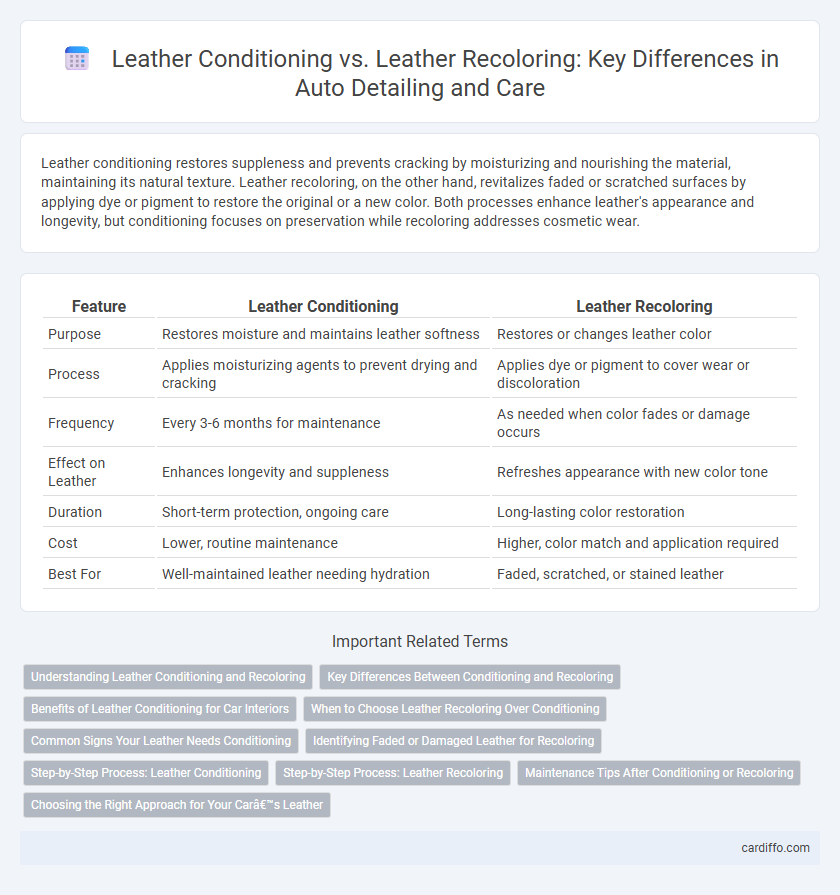Leather conditioning restores suppleness and prevents cracking by moisturizing and nourishing the material, maintaining its natural texture. Leather recoloring, on the other hand, revitalizes faded or scratched surfaces by applying dye or pigment to restore the original or a new color. Both processes enhance leather's appearance and longevity, but conditioning focuses on preservation while recoloring addresses cosmetic wear.
Table of Comparison
| Feature | Leather Conditioning | Leather Recoloring |
|---|---|---|
| Purpose | Restores moisture and maintains leather softness | Restores or changes leather color |
| Process | Applies moisturizing agents to prevent drying and cracking | Applies dye or pigment to cover wear or discoloration |
| Frequency | Every 3-6 months for maintenance | As needed when color fades or damage occurs |
| Effect on Leather | Enhances longevity and suppleness | Refreshes appearance with new color tone |
| Duration | Short-term protection, ongoing care | Long-lasting color restoration |
| Cost | Lower, routine maintenance | Higher, color match and application required |
| Best For | Well-maintained leather needing hydration | Faded, scratched, or stained leather |
Understanding Leather Conditioning and Recoloring
Leather conditioning penetrates the material to restore moisture, prevent cracking, and maintain suppleness using specialized oils and conditioners. Leather recoloring involves applying pigments or dyes to cover wear, scratches, or fading, effectively renewing the leather's appearance and color uniformity. Proper understanding of both processes is essential for preserving the longevity and aesthetics of leather surfaces in automotive and furniture detailing.
Key Differences Between Conditioning and Recoloring
Leather conditioning replenishes natural oils and moisture to maintain softness and prevent cracking, while leather recoloring restores or changes the color to cover fading, scratches, or discoloration. Conditioning preserves the leather's original appearance without altering its color, whereas recoloring modifies the surface pigmentation to achieve a uniform look or a new shade. Both processes extend leather life, but conditioning focuses on nourishment and protection, and recoloring emphasizes cosmetic restoration.
Benefits of Leather Conditioning for Car Interiors
Leather conditioning enhances the durability and suppleness of car interiors by deeply moisturizing the leather, preventing cracks and fading caused by sun exposure. It maintains the original texture and color, preserving the luxury feel and resale value of the vehicle. Regular conditioning also protects against stains and wear, ensuring the interior remains visually appealing and comfortable over time.
When to Choose Leather Recoloring Over Conditioning
Leather recoloring is ideal when the leather surface exhibits deep scratches, fading, or significant discoloration that conditioning alone cannot restore. Conditioning replenishes moisture and maintains suppleness but does not address color loss or surface damage effectively. Choose leather recoloring for a comprehensive color restoration and renewed appearance on heavily worn or visibly damaged leather items.
Common Signs Your Leather Needs Conditioning
Common signs your leather needs conditioning include dryness, stiffness, and visible cracks on the surface, indicating depleted natural oils. Faded color and loss of suppleness are key indicators that conditioning is necessary to restore moisture and flexibility. Unlike leather recoloring, which addresses discoloration and scratches, conditioning prevents further damage by maintaining the leather's softness and durability.
Identifying Faded or Damaged Leather for Recoloring
Faded or damaged leather shows visible signs such as discoloration, scratches, or dryness that cannot be fully restored through conditioning alone. Leather conditioning replenishes oils and moisture to maintain suppleness, but recoloring is required to address surface fading and color loss effectively. Identifying these issues early ensures the correct treatment is applied, preserving the leather's appearance and extending its lifespan.
Step-by-Step Process: Leather Conditioning
Leather conditioning begins with thoroughly cleaning the surface to remove dirt and oils, ensuring optimal absorption of the conditioner. Applying a high-quality leather conditioner using a soft cloth, work it evenly into the leather in circular motions, allowing the material to regain moisture and flexibility. After letting the conditioner penetrate for 15-30 minutes, buff the surface with a dry microfiber cloth to restore shine and protect against future wear.
Step-by-Step Process: Leather Recoloring
Leather recoloring involves a meticulous step-by-step process beginning with a thorough cleaning to remove dirt, oils, and existing finish. The next phase includes carefully applying the chosen recoloring product in thin, even layers, allowing each coat to dry fully to ensure uniform color restoration. The final step usually consists of sealing the leather with a protective coating to enhance durability and maintain the refreshed appearance.
Maintenance Tips After Conditioning or Recoloring
Leather conditioning restores moisture and suppleness, preventing cracks and prolonging the lifespan of leather, while leather recoloring enhances color vibrancy and covers imperfections. Post-conditioning, avoid direct sunlight and heat exposure to preserve the leather's integrity, and reapply conditioner every 3-6 months depending on usage. After recoloring, allow sufficient drying time and apply a protective topcoat or sealant to maintain the finish and prevent color fading or peeling.
Choosing the Right Approach for Your Car’s Leather
Leather conditioning restores moisture, enhances suppleness, and extends the lifespan of your car's leather upholstery by preventing cracks and wear. Leather recoloring addresses surface discoloration, scratches, and fading by applying specialized dyes to rejuvenate the original appearance. Selecting the right approach depends on the leather's condition: use conditioning for maintenance and minor wear, and opt for recoloring when significant damage or color loss occurs.
Leather Conditioning vs Leather Recoloring Infographic

 cardiffo.com
cardiffo.com